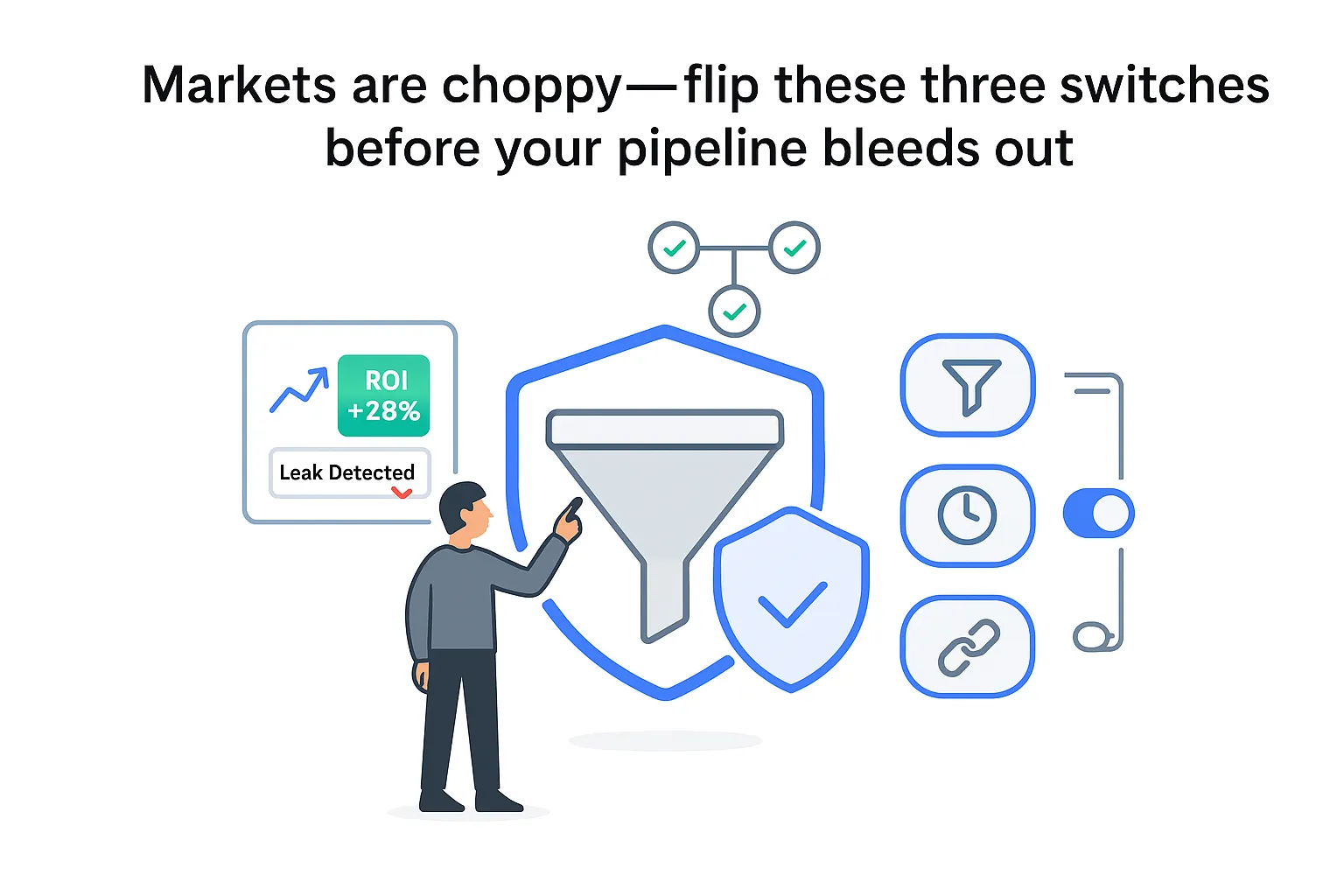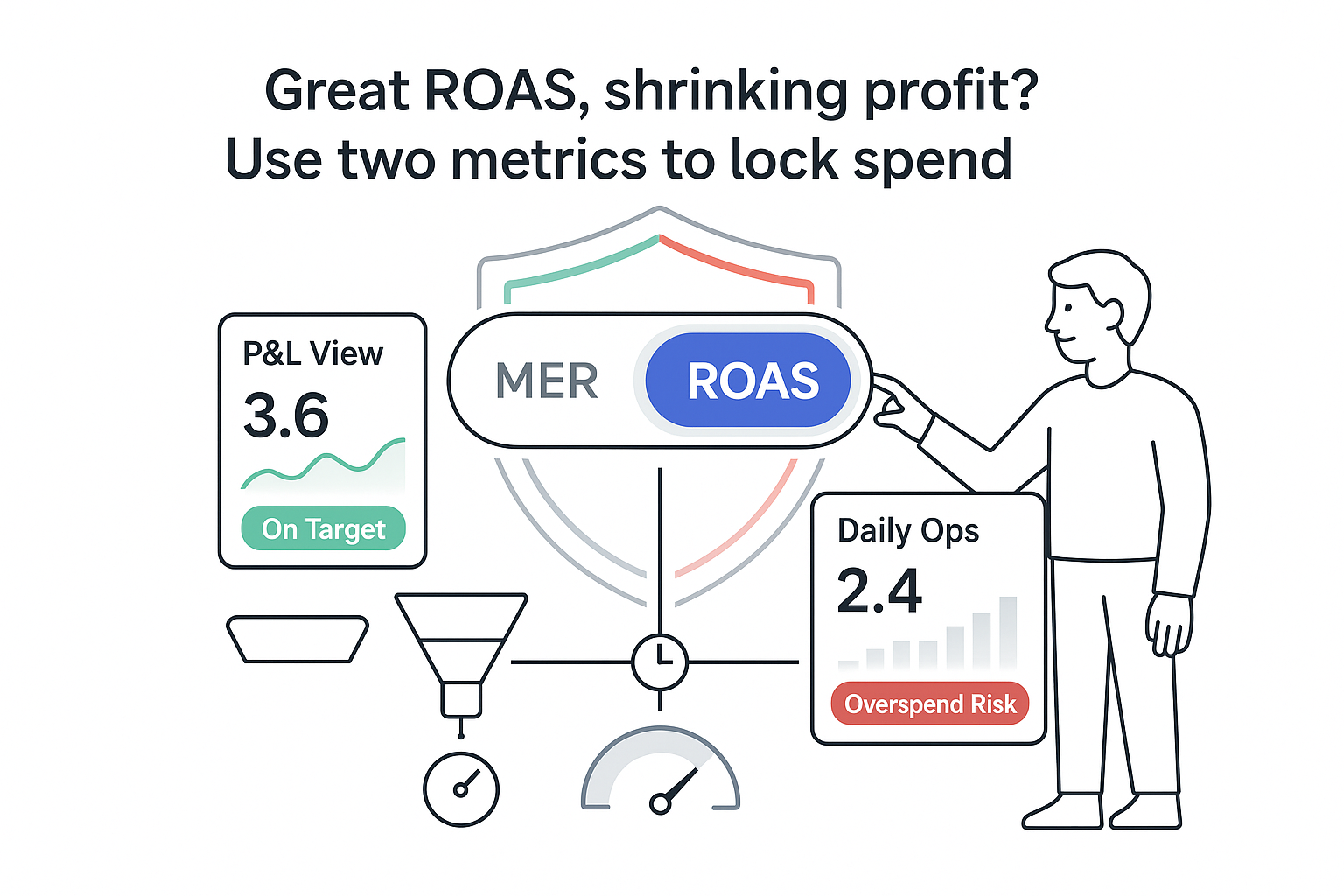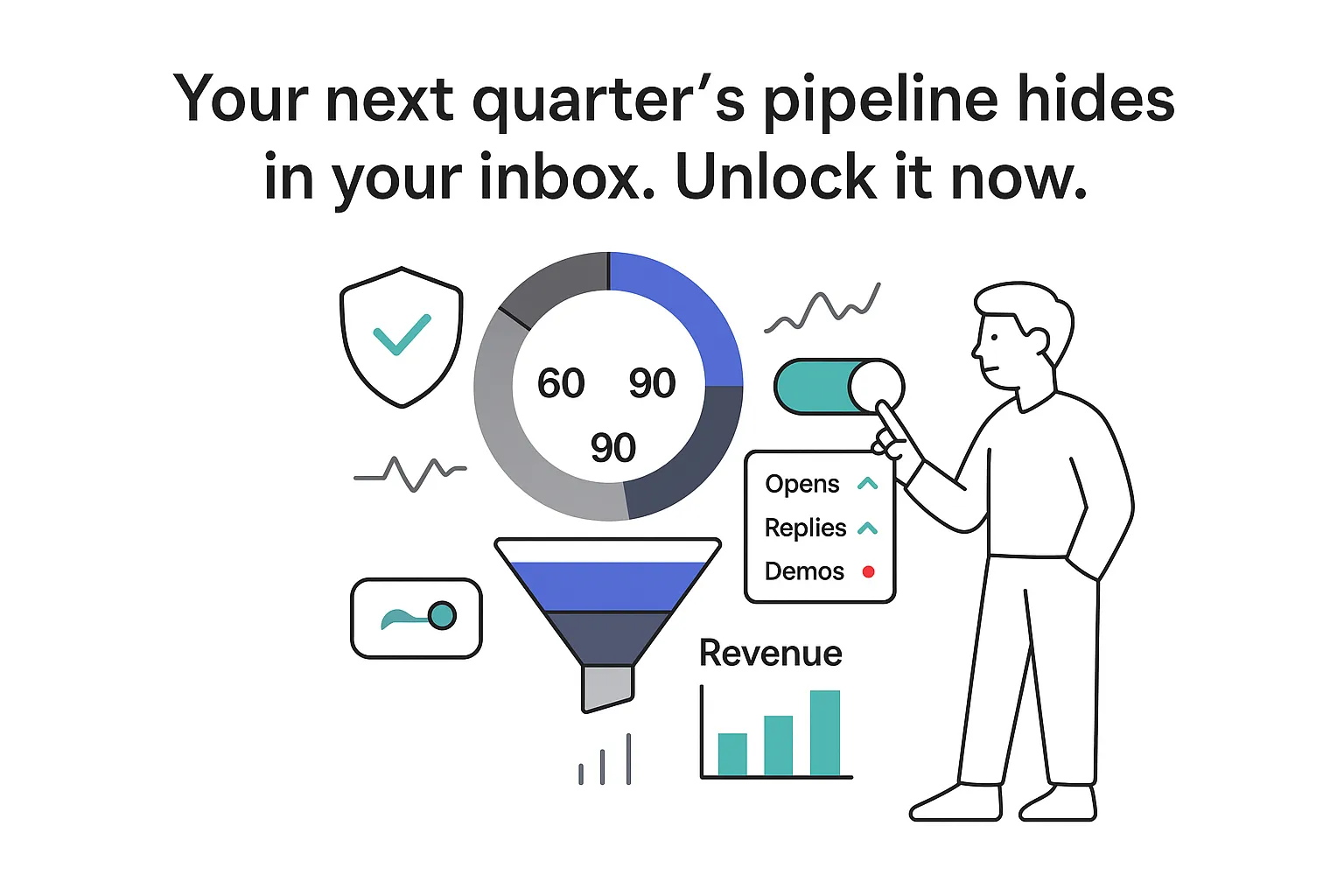The market is choppy, budgets are tight, and patience is thinner than ever. Still, this is exactly when clear heads win. If you lead a B2B service company, the play is not to go quiet. The play is to protect the pipeline, cut waste not growth, and double down on channels that compound. I call that practical courage - marketing in a downturn done right.
Marketing in a downturn
If you are asking what to do right now, start with three moves. First, protect revenue already near the finish line. Second, trim anything that does not earn pipeline. Third, reinforce compounding channels that reduce cost per lead over time. CEOs do not need fluff here; they need numbers. Retaining customers is often cheaper than chasing new ones - acquisition can be 25 times more expensive - so protect the revenue closest to closing while you shore up compounding channels.
A few proof points steady the hand. McGraw-Hill's analysis of the 1981-1982 recession found companies that kept or grew advertising saw roughly 250 percent higher sales by 1985 than those that cut. IPA data (Binet & Field) shows that gaining excess share of voice (your share of voice above your share of market) often leads to share of market growth within 6 to 18 months, even during recessions. Nielsen has reported that pausing brand activity for as little as six months can cut total awareness by double digits, which means paying more later to rebuild what slipped.
So yes, marketing in a downturn feels risky. But cutting compounding spend often creates a bigger bill next quarter. For B2B services, timing expectations should be explicit. I typically see visible impact in these windows: 30 to 45 days for conversion rate lifts and bottom-of-funnel (BoFu) content refreshes, 45 to 90 days for search ranking movement on mid-difficulty terms, and 90 to 120 days for pipeline value growth you can attribute with confidence in your analytics and CRM.
Step one: pause with purpose
Freezing is not pausing. Pausing means diagnose, clean up, and aim your resources at what will move the needle now. Give yourself 30 days to rebase the plan, then step back on the gas.
In 30 days, I audit:
- Channel math: current CAC by source, LTV by segment, and payback period pulled from CRM.
- Pipeline quality: SQL rate, win rate, and pipeline velocity by source over the last 90 days.
- Search position: rankings for money pages, click-through rate, and coverage of priority keywords.
- Content quality: thin pages, duplicate intent, and proof gaps versus top competitors.
- Website performance: page speed on top landing pages, form friction, and UX failures that leak demand.
- Budget rules: keep, kill, or scale by source using ICE (Impact, Confidence, Ease) or RICE (Reach included) scoring.
- Messaging: headline, proof, and offer tightness on BoFu pages and ads.
- Reporting: owner per KPI and clean attribution in analytics and CRM so decisions are defensible.
The hidden cost of going dark is real. Share of voice decay tends to preface share of market decline; if your share of voice falls below your share of market (negative ESOV), you usually shrink in the next few quarters. SEO decays: rankings drift, link velocity slows, crawl frequency dips, and rivals capture your click share - regaining a top-three position often takes two to four times the effort it would have taken to hold it. Paid dependency rises, so CAC spikes; renting attention is pricier than owning it. And when brand search erodes, every channel looks worse in the dashboard, which tempts further cuts - exactly the loop to avoid.
A quick scenario makes the point. Imagine 200 monthly MQLs, 25 percent to SQL, and a 20 percent win rate, with 40-day velocity. If you pause content and link acquisition for one quarter, organic MQLs dip 25 percent, branded search falls 15 percent, and blended CAC climbs from 950 to 1,150. To hit the same bookings, you add paid, but CPAs are higher without brand lift. Net effect over two quarters is often negative, even if spend briefly falls.
Step two: pivot what I say and where I spend
Customers did not stop caring; they shifted what they care about. I pivot messaging to match recession pains - risk, ROI, and efficiency - and I reallocate toward channels that compound. Word-of-mouth remains powerful for many small businesses - 85% of small biz owners say word-of-mouth is their top growth channel - so lean into partner and customer advocacy alongside performance channels.
Reframe the narrative
- Risk reduction: shorter commitments, transparent scope, clear exit points.
- ROI confidence: outcome-based milestones, shared scorecards, numbers not adjectives.
- Efficiency: integrations that remove manual steps, playbooks that cut cycles, fewer handoffs.
Reallocate toward efficient, compounding channels
- SEO, digital PR, and review signals that keep delivering after you publish.
- Partner and co-marketing that share audiences and split costs.
- Conversion work on pages already ranking or getting paid traffic.
Align messages by ICP and funnel stage
- CIO or Head of Ops, top of funnel: pragmatic pieces on cost control without tech debt; simple calculators that estimate time saved.
- CFO, mid funnel: case stories with payback and risk controls; a one-page model of cost avoided.
- Founder or GM, bottom of funnel: pilot outline, timeline, decision checklist, ROI guardrails and outcome options.
B2B service examples that lower perceived risk
- Guarantee frameworks: a pilot with fixed fee and fixed output, then a go-forward plan if targets are met.
- Bundled retainers: program fees that include analytics and conversion tracking so outcomes are visible.
- Focused pilots: a 45-day test for one ICP on one channel with one success metric.
- Value calculators: analytics-assisted revenue or CRM influence models translated into simple buyer-facing calculators.
Plays that pay faster
- Refresh BoFu pages: tighten Services, case studies, and pricing; add quantified proof above the fold and a simple timeline.
- Create comparison and alternative pages: prospects search your brand versus category leaders; be fair, be clear, and link to buyer guides.
- Update proof assets: turn three strong projects into short ROI stories with charts and clear before-after.
- Build one webinar and repurpose it: one live session becomes short clips for LinkedIn, a summary post, and an email sequence.
- Partner co-marketing: guest in each other's events and share a compact research angle both sales teams can use.
- Review site optimization: keep profiles current with fresh quotes, tags, and clear use cases.
- Speed and UX fixes: compress images, preconnect key domains, and simplify forms to two fields on consult pages.
A sample 90-day sprint
- Weeks 1-2: audit data, fix tracking, refresh top CTAs.
- Weeks 3-4: update Services and Case Study pages, speed fixes, add structured data where natural.
- Weeks 5-6: publish two comparison pages and one buyer guide; host the webinar.
- Weeks 7-8: repurpose webinar into clips and posts; kick off two partner campaigns.
- Weeks 9-10: launch a data-driven PR angle; add three fresh testimonials.
- Weeks 11-12: consolidate thin posts into clusters; expand internal links to BoFu pages.
SEO when budgets tighten
When budgets tighten, pick compounding, measurable wins. SEO in a downturn is not about more content; it is about better intent matching, better structure, and obvious proof.
Priorities that pay back
- Consolidate thin pages: merge look-alike posts, redirect, keep the version with links and history.
- Build topical clusters around Services and Industries: each cluster points to the pillar page and answers real buyer questions.
- Internal linking that feeds BoFu: from related posts, case studies, and the homepage into money pages.
- Digital PR to fill authority gaps: data studies and expert commentary that earn coverage and links.
- Refresh high-value posts with current facts: update stats, add new examples, and reindex.
- CRO on top-intent pages: a small lift on a high-intent page beats a big lift on a low-intent page.
- Add FAQs and how-tos when intent asks for them: concise answers that can win snippets.
A pragmatic 30-60-90 approach
- 30 days: audit site structure, fix internal links, refresh the top five posts, accelerate top landing page speed, and confirm conversion tracking.
- 60 days: ship two clusters with five pages each, publish one data study with a simple chart, pitch it to industry editors, and add review signals to case studies.
- 90 days: expand clusters with fresh subtopics, launch a partner content series, tighten schema, and iterate CTAs/forms with qualitative UX insights and A/B tests.
KPI stack that keeps focus
- SQLs from organic and assisted revenue attributed in analytics and CRM.
- Pipeline value influenced by organic and by partner content.
- Rankings for money pages, not vanity keywords.
- Branded search volume trend and click share.
- Conversion rate on the top three BoFu pages.
Step three: operate to outpace competitors
Once the plan is set, cadence wins. I turn the pivot into an operating rhythm that keeps the team focused and the board calm.
A 90-day rhythm
- Weekly 30-minute business review: pipeline movement, live tests, and blockers only.
- Owner per KPI: one for SQLs, one for pipeline, one for conversion rate, one for rankings.
- Simple red-amber-green dashboards: red needs a fix this week, amber needs a plan, green continues.
- Forecast scenarios with spend guardrails: base, downside, and upside, with rules for when to pull spend back or move it forward.
Measure ROI without the headaches
- Use first- and last-touch views in analytics, then backstop with CRM influence models.
- Track SQLs, pipeline value, and bookings tied to key pages and content clusters.
- Maintain clean UTM hygiene; if I cannot tag it, I cannot trust it.
- Do not chase perfect attribution; aim for decision-quality clarity that points to the next move.
Trigger rules that keep me honest
- If a channel meets cost-per-SQL and velocity targets for four weeks, scale it 20 percent.
- If it misses cost-per-SQL by 30 percent for three weeks, cut it back, fix the variable, then retest.
- If a test shows power-law returns, shift budget immediately - within guardrails agreed in advance.
I keep systems simple: a reliable analytics stack, a CRM with clear lifecycle stages, search visibility tracking, UX feedback from real sessions, and an A/B testing habit. The tools matter less than the discipline to look at the same signals each week and act on them.
Decide not to participate
Asked how he would respond to a recession, Sam Walton reportedly said, "I thought about it and decided not to participate."
That is not denial; it is discipline. It means I keep showing up, spend smarter, and take share while rivals step back. It means I keep the message tight, the proof visible, and the engine running even when the weather looks rough.
Across companies that treat downturns as a chance to focus, three patterns repeat. They pause with purpose for 30 days to diagnose. They pivot to offers and messages that reduce risk and raise confidence. Then they operate a clear cadence and outpace competitors who went quiet. Results rarely arrive overnight - but they stack, and that is exactly the point.
Ready to move with purpose? Press Play.







.svg)